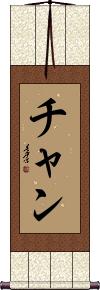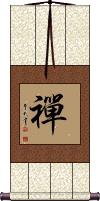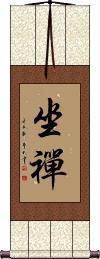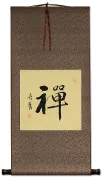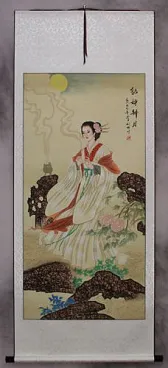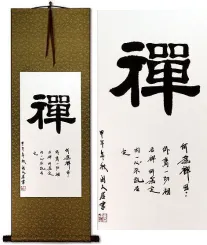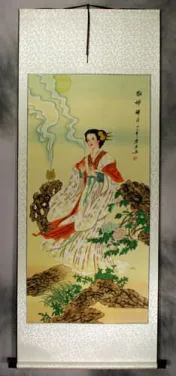Many custom options...
And formats...

Chan in Chinese / Japanese...
Buy a Chan calligraphy wall scroll here!
Personalize your custom “Chan” project by clicking the button next to your favorite “Chan” title below...
Chan
Zen / Chan / Meditation
...as in Zen Buddhism
First, let's correct something: The Japanese romanization for this character, “Zen” has penetrated the English language. In English, it's almost always incorrectly used for phrases like “That's so zen.” Nobody says, “That's so meditation” - right? As the title of a sect, this would be like saying, “That's so Baptist!"
禪 by itself just means “meditation.” In that context, it should not be confined to use by any one religion or sect.
Regardless of the dictionary definition, more often than not, this character is associated with Buddhism. And here is one of the main reasons:
Zen is used as the title of a branch of Mahayana Buddhism, which strongly emphasizes meditation practice.
However, it should be noted that Buddhism came from India, and “Chan Buddhism” evolved and developed in medieval China. The Chinese character “Chan” was eventually pronounced as “Zen” in Japanese. Chan Buddhists in China have much in common with Zen Buddhists in Japan.
More about the history of Zen Buddhism here.
Please also note that the Japanese Kanji character for Zen has evolved a little in Japan, and the two boxes (kou) that you see at the top of the right side of the character have been replaced by three dots with tails.
 The original character would still be generally understood and recognized in Japanese (it's considered an ancient version in Japan) but if you want the specifically modern Japanese version, please click on the zen Kanji to the right. Technically, there is no difference between the Tensho and Reisho versions of Zen since they are ancient character styles that existed long before Japan had a written language.
The original character would still be generally understood and recognized in Japanese (it's considered an ancient version in Japan) but if you want the specifically modern Japanese version, please click on the zen Kanji to the right. Technically, there is no difference between the Tensho and Reisho versions of Zen since they are ancient character styles that existed long before Japan had a written language.![]() There is also an alternate/shorthand/simplified Chinese version, which has two dots or tails above the right-side radical. This version is also popular for calligraphy in China. If you want this version, just click the character to the right.
There is also an alternate/shorthand/simplified Chinese version, which has two dots or tails above the right-side radical. This version is also popular for calligraphy in China. If you want this version, just click the character to the right.
Further notes: Zen is just one of seven sects of Buddhism practiced in Japan. The others are 律 Ritsu (or Risshū), 法相 Hossō, 論 Sanron 華嚴 Kegon, 天台 Tendai, and 眞言 Shingon.
Sit in Meditation
Zazen
坐禪 describes the act of sitting in a state of deep meditation.
You'll notice that the second character is Chan/Zen (often used to title the meditative form of Buddhism).
In Korean Hanja, this means “religious meditation” (roughly the same as the Chinese definition).
Buddhists may define this as sitting in dhyāna, abstract meditation, fixed abstraction, or contemplation.
 Japanese note: This will make sense in Japanese but the Kanji shown to the left are partially in ancient/traditional Japanese form. Japanese Buddhists may use 坐禪, 坐禅, 座禪, or 座禅. The most standard/modern Japanese form of this word is shown to the right. Click on the Kanji to the right (instead of the button above) if you want this specifically Japanese version.
Japanese note: This will make sense in Japanese but the Kanji shown to the left are partially in ancient/traditional Japanese form. Japanese Buddhists may use 坐禪, 坐禅, 座禪, or 座禅. The most standard/modern Japanese form of this word is shown to the right. Click on the Kanji to the right (instead of the button above) if you want this specifically Japanese version.
This in-stock artwork might be what you are looking for, and ships right away...
Gallery Price: $72.00
Your Price: $39.77
Gallery Price: $108.00
Your Price: $59.88
Gallery Price: $232.00
Your Price: $128.88
Not the results for Chan that you were looking for?
Below are some entries from our dictionary that may match your Chan search...
| Characters If shown, 2nd row is Simp. Chinese |
Pronunciation Romanization |
Simple Dictionary Definition |
參禪 参禅 see styles |
cān chán can1 chan2 ts`an ch`an tsan chan noshi wo ri |
More info & calligraphy: Zen UnderstandingTo inquire, discuss, seek religious instruction. |
坐禪 坐禅 see styles |
zuò chán zuo4 chan2 tso ch`an tso chan zazen |
More info & calligraphy: Sit in MeditationTo sit in dhyāna, i.e. abstract meditation, fixed abstraction, contemplation; its introduction to China is attributed to Bodhidharma (though it came earlier), and its extension to Tiantai. |
安禪 安禅 see styles |
ān chán an1 chan2 an ch`an an chan anzen |
More info & calligraphy: Reach Peace and Calm Through Meditation |
禪宗 禅宗 see styles |
chán zōng chan2 zong1 ch`an tsung chan tsung Zenshū |
More info & calligraphy: Zen BuddhismThe Chan, meditative or intuitional, sect usually said to have been established in China by Bodhidharma, v. 達, the twenty-eighth patriarch, who brought the tradition of the Buddha-mind from India. Cf. 楞 13 Laṅkāvatāra sūtra. This sect, believing in direct enlightenment, disregarded ritual and sūtras and depended upon the inner light and personal influence for the propagation of its tenets, founding itself on the esoteric tradition supposed to have been imparted to Kāśyapa by the Buddha, who indicated his meaning by plucking a flower without further explanation. Kāśyapa smiled in apprehension and is supposed to have passed on this mystic method to the patriarchs. The successor of Bodhidharma was 慧可 Huike, and he was succeeded by 僧璨 Sengcan; 道信 Daoxin; 弘忍 Hongren; 慧能 Huineng, and 神秀 Shenxiu, the sect dividing under the two latter into the southern and northern schools: the southern school became prominent, producing 南嶽 Nanyue and 靑原 Qingyuan, the former succeeded by 馬祖 Mazu, the latter by 石頭 Shitou. From Mazu's school arose the five later schools, v. 禪門. |
禪心 禅心 see styles |
chán xīn chan2 xin1 ch`an hsin chan hsin zenshin |
More info & calligraphy: Zen Heart / Zen Mind |
禪悅 禅悦 see styles |
chán yuè chan2 yue4 ch`an yüeh chan yüeh zenetsu |
More info & calligraphy: Inner Bliss and Peace from Meditation |
丳 see styles |
chǎn chan3 ch`an chan |
skewer |
僝 see styles |
chán chan2 ch`an chan |
to revile; to abuse |
儃 see styles |
chán chan2 ch`an chan |
indecisive; irresolute |
儳 see styles |
chàn chan4 ch`an chan |
irregular; mixed |
剗 刬 see styles |
chǎn chan3 ch`an chan |
variant of 鏟|铲[chan3] |
剷 铲 see styles |
chǎn chan3 ch`an chan |
to scrape the ground with a spade (to make it level or to remove weeds); to shovel |
劖 see styles |
chán chan2 ch`an chan |
bore; cut; polish |
嚵 see styles |
chàn chan4 ch`an chan |
(literary) animal's mouth or beak |
囅 冁 see styles |
chǎn chan3 ch`an chan |
smilingly |
嬋 婵 see styles |
chán chan2 ch`an chan |
used in 嬋娟|婵娟[chan2juan1] and 嬋媛|婵媛[chan2yuan2] |
孱 see styles |
chán chan2 ch`an chan |
(bound form) weak; feeble |
嵼 𡶴 see styles |
chǎn chan3 ch`an chan |
winding mountain path |
巉 see styles |
chán chan2 ch`an chan |
(literary) steep; rugged; jagged; precipitous |
幨 see styles |
chān chan1 ch`an chan |
curtain in carriage; screen |
廛 see styles |
chán chan2 ch`an chan |
market place |
懺 忏 see styles |
chàn chan4 ch`an chan sen |
(bound form) to feel remorse; (bound form) scripture read to atone for sb's sins (from Sanskrit "ksama") kṣamayati, "to ask pardon"; to seek forgiveness, patience or indulgence, kṣamā meaning patience, forbearance, tr. as 悔過 repentance, or regret or error; also as confession. It especially refers to the regular confessional service for monks and for nuns. |
攙 搀 see styles |
chān chan1 ch`an chan |
to take by the arm and assist; to mix; to blend; to dilute; to adulterate |
旵 see styles |
chǎn chan3 ch`an chan |
(literary) (of sunlight) to beam down; to illuminate; (used in place names and given names) |
梴 see styles |
chān chan1 ch`an chan |
length (of a tree or beam); long |
欃 see styles |
chán chan2 ch`an chan |
sandalwood (Santalum album), a Nepalese tree producing valuable fragrant oil; comet |
毚 see styles |
chán chan2 ch`an chan |
cunning; artful |
滻 浐 see styles |
chǎn chan3 ch`an chan |
name of a river in Shaanxi province; see 滻河|浐河[Chan3 He2] |
潺 see styles |
chán chan2 ch`an chan |
flow; trickle (of water) |
澶 see styles |
chán chan2 ch`an chan |
still (as of water); still water |
Click here for more Chan results from our dictionary
The following table may be helpful for those studying Chinese or Japanese...
| Title | Characters | Romaji (Romanized Japanese) | Various forms of Romanized Chinese | |
| Chan | チャン | chan | ||
| Zen Chan Meditation | 禪 禅 | zen | chán / chan2 / chan | ch`an / chan |
| Sit in Meditation | 坐禪 坐禅 | za zen / zazen | zuò chán / zuo4 chan2 / zuo chan / zuochan | tso ch`an / tsochan / tso chan |
| In some entries above you will see that characters have different versions above and below a line. In these cases, the characters above the line are Traditional Chinese, while the ones below are Simplified Chinese. | ||||
Successful Chinese Character and Japanese Kanji calligraphy searches within the last few hours...
